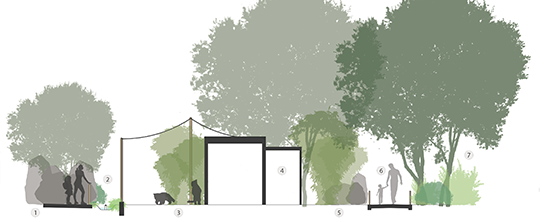Zoos and Landscape Performance
The role of zoos have evolved over the centuries to become complex spaces that blend natural and built landscapes, property operations, and institutional goals. As public institutions, they are redefining their purpose to focus less on entertainment and more on conservation, species protection, and education. How do zoo landscapes support the key roles and functions that zoos have within society and for the environment, and how does their design achieve their institutional goals?
A landscape performance approach is particularly useful in highly specialized landscapes like zoos. During Alexander Green’s MLA studies at the University of Florida, his interests in zoo design and landscape performance converged in his terminal project “Understanding Potential: Recognizing Landscape Performance in Zoological Landscapes,” advised by Dr. Yi Luo, Prof. Michael Volk, and Prof. Daniel Manley. This project explored the identifiable contributions or benefits that can be achieved in zoological landscapes, how they are achieved, and how their value is measured or quantified. He also explored the role that landscape architects can play in facilitating benefits for zoos. The project received a 2022 Student Design Award of Honor (Research and Communications Category) from the Florida ASLA and is the first known exploration of landscape performance related specifically to zoological landscapes.

To frame his research, Alexander consulted the Landscape Architecture Foundation’s Landscape Performance Series and Evaluating Landscape Performance: A Guidebook for Metrics and Methods Selection. Using the Association of Zoos & Aquariums (AZA) awards as a way to identify high-performing zoos and well-designed exhibits, he reviewed the award packets for eleven case studies of real-life zoos and identified which of the 33 landscape performance benefits in the Landscape Performance Series were represented.
Based on literature review and case study analysis, Alexander first developed an understanding of what a zoological landscapes entail, going far beyond just physical landscape elements. He also explored how zoo operations and institutional goals could contribute towards achieving measurable benefits. Through this framework, he found that all benefits described in the Landscape Performance Series could theoretically be achieved within zoological landscapes. The most commonly achieved benefits for the zoos and exhibits analyzed by Alexander included safety, educational value, job creation, visitor spending, and tax revenue.
Alexander found that many of the key benefits offered by zoos were outside of the realm of what typically falls under the purview of the landscape architect, but he states that the visualization and problem solving skills of landscape architects could serve as a significant asset when developing ideas for new exhibits and physical planning for zoo landscapes. He also describes an important potential role for landscape architects in maximizing benefits related to maintenance and operations through careful site design and collaboration.
There are no zoos among the Landscape Performance Series Case Study Briefs as of 2023. As Alexander discusses at the conclusion to his terminal project report, there is much more work to be done in the future to document the environmental, social, and economic contributions of zoological landscapes—particularly as zoos continue to evolve with changing norms and a changing climate.
